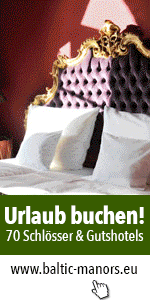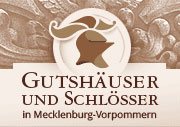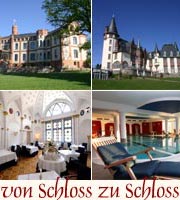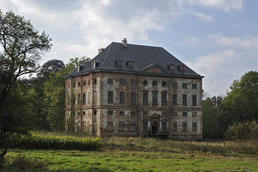Deutsche Website
Castle, Manor House or Farm House?

Information about the classification castle, manor house or farmhouse. Surely you must have asked yourself by which criteria we sorted the listing of manor houses and castles.
Castle and Hunting Lodge Rossewitz
Rossewitz lies isolated in the middle of fields, meadows and woods; a manor house of indescribable charm. The Rossewitz estate was under the ownership of the von Moltke family, then the von Normann (Nortman) family and from 1450 to 1782 the Vieregge family.
There was already a castle in Rossewitz in the Middle Ages, the residence of the Normann (Nortman) family, who owned a large number of estates in the surrounding areas. Curt Nortman sold the property to his brother-in-law Vicke Vieregge on 20 October 1450, which was then enfeoffed with Rossewitz and the surrounding estates by Duke Heinrich IV. von Mecklenburg. The Vieregge (Viereck) family resided on Rossewitz from then on. Joachim Heinrich von Vieregge, who had served as a Major General in the Thirty Years War, had a new manor house built in 1657 in Italian style on the foundations of the castle which had been destroyed in the last war and is regarded as the first baroque building in Mecklenburg. It was finished in 1680. The designs came from Charles Philipp Dieussart, a French Huguenot, who came to Mecklenburg via Holland and Hamburg and also designed the gatehouse at Güstrower Palace, amongst others.
Rossewitz was under the ownership of the Schwerin Ducal Chamber Schwerin starting in 1780 and was used as a hunting lodge by Friedrich Franz I. It later became a demesne estate and was tenanted by the von Voss family. The manor house was already not at its best in 1930 and started to become derelict. It was a home for many refugee families from 1945 to 1972. After the last resident had left in 1973, it visibly deteriorated. The DEFA (publicly owned film studio in the DDR) film “Elective Affinities” based on Goethe was filmed within its walls in 1973. The manor, standing empty after that, was ransacked and in the mid-1980s the roof and ceilings fell in. Safety measures were taken by the Deutsche Stiftung Denkmalschutz (German Conservation Foundation). Remains of the park are preserved.
Architecture:
Rossewitz is an impressive rendered brick building with nine sets of windows and three short wings at the rear. Four storeys, each with a main and mezzanine floor, separated by a strong fascia and a high cellar make the manor house appear unusually tall for Mecklenburg proportions. The faҫade is dominated by a three winged avant-corps, stepped on both sides by square pilasters with Corinthian pillars. The cornice with corbels and metopes, showing motives from the Thirty Years War, are made of fired clay. Dark grey sandstone was used for the garlands of fruit underneath the windows of the avant-corps as well as for the festoons over which there are three bull’s-eye windows which serve as extra illumination for the hall. The entrance however is stepped with square pilasters and a triangular gable taking up the concept of the avant-corps. The foyer is divided by blind arcades and pilasters, with a frieze of triglyphs and metopes above it. One of two stairways leads – passing by the “Piefkes Stube” – into the great ballroom which joins the main and mezzanine floor and takes in the whole depth of the manor house. The fragments of illusionist architectural painting from 1680 have been largely restored during the course of the safety and restoration work. There are medallions over the doors with pictures of Arcadian landscapes from 1781 to 1784 by J.F. Fechhelm. There are marble fireplaces and valuable pieces in the whole manor house, however they are badly damaged or only existing as fragments. The secret stairs and the hidden ventilation or heating systems in the walls are worth further attention. These have recently been systematically researched. The well in the cellar is also interesting, as it is less than two metres deep. The lack of depth was to prevent the water from standing too long, as water always flows into it.
Viewing times:
Guided tours are currently no longer offered.
Directions:
It is not terribly simple to reach Rossewitz by car. It is a question of luck if you can reach your destination over the country lanes. However a road will lead you to it.




